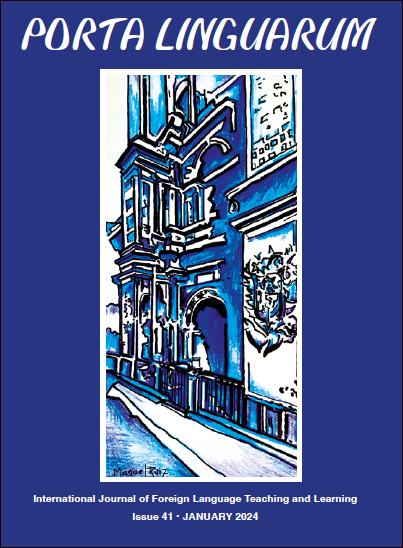Effect of language learning strategies on vocabulary development in CLIL
DOI:
https://doi.org/10.30827/portalin.vi41.27217Keywords:
language learning strategy, CLIL, vocabulary acquisition, English, lower-secondary pupilsAbstract
This study focuses on language learning strategy use examined in the context of Content and Language Integrated Learning (CLIL) with a specific focus on productive vocabulary development in a school year time frame.
The research took place in the Czech Republic, a sample comprised of 286 pupils ranging from 11 to 14 years of age, a total of 12 classes spread over three schools. Half of the experimental group had one year of CLIL experience prior to the study. The content subjects in the experimental classes were History and Civics; the language of instruction was English. The study aimed at finding out what is the connection between language learning strategies and vocabulary acquisition in CLIL classes.
Standardized Laufer & Nation’s vocabulary levels tests and Oxford’s Strategy Inventory for Language Learning served as data collection instruments. Variables taken into consideration were CLIL experience, gender, content subject and teacher. The previous year of CLIL and the teacher turned out to be significant. Concerning the questionnaires, five strategies showed a positive influence on the growth of productive vocabulary. Surprisingly enough, five strategies negatively impacted vocabulary. Strategies using a task-based methodology proved superior to purely vocabulary-based strategies.
Downloads
References
Adan, D. A., & Hashim, H. (2021). Language learning strategies used by art school ESL learners. Creative Education, 12, 653-665. https://doi.org/10.4236/ce.2021.123045
Coyle, D. (2011). ITALIC research report – investigating students gains: Content and language integrated learning. Aberdeen: University of Aberdeen.
Dale, L., van der Es, W., & Tanner, R. (2011). CLIL skills. Leiden: Expertisecentrum mvt.
Dalton-Puffer, C., & Smit U. (2013). Thinking allowed. Content and language integrated learning: A research agenda. Language Teaching, 46.4, 545-559. doi:10.1017/S0261444813000256
Deller, S., & Price, Ch. (2007). Teaching other subjects through English. Oxford: Oxford University Press.
De Zarobe, Y. R. (2010). First languages and age in CLIL and non-CLIL contexts. International CLIL Research Journal, 3(1), 61–66.
Ellis, R. (2003). Task-based language learning and teaching. Oxford: Oxford University Press.
Habók, A., & Magyar, A. (2018). The effect of language learning strategies on proficiency, attitudes and school achievement. Frontiers in Psychology 8, 1-8. doi: 10.3389/fpsyg.2017.02358
Jaikrishnan, S., & Ismail, H. H. (2021). A review on vocabulary learning strategies used in learning English as a second language. International Journal of Academic Research in Business and Social Sciences, 11(9), 297–309.
Lasagabaster, D., & Sierra, J. M. (2009). Language attitudes in CLIL and traditional EFL classes. International CLIL Research Journal, 2(1), 5-18.
Marsh, D. (2013). The CLIL trajectory: Educational innovation for the 21st century iGeneration. Córdoba: Servicio de publicaciones de la Universidad de Córdoba.
Mehisto, P., Marsh, D., & Frigols, M.J. (2008). Uncovering CLIL. Content and language integrated learning in bilingual and multilingual education. Oxford: Macmillan.
Mehrabian, N., & Salehi, H. (2019). The effects of using diverse vocabulary learning strategies on word mastery: a review paper. Journal of Applied Studies in Language, 3(1), 100-114.
Min, T. S., Wei, C. X., Rohaizat, N., Mohamed, K., Nie, A. F., & Hashim, H. (2021). Language learning strategies in acquiring English language skills among year 5 pupils in rural areas in southern Malaysia. International Journal of Academic Research in Business and Social Sciences, 11(7), 1247–1256.
Norris, J., & Ortega, L. (2000). Effectiveness of L2 instruction: A research synthesis and quantitative meta-analysis. Language Learning, 50, 417-528.
Oxford, R. L. (1990). Language learning strategies: What every teacher should know, Boston, USA: Heinle & Heinle Publishers.
Oxford, R. L. (2003). Language learning styles and strategies: Concepts and relationships. IRAL, 41, 271-278. https://doi.org/10.1515/iral.2003.012
Seikulla-Leino, J. (2007). CLIL learning: Achievement levels and affective factors. Language and Education, 21(4), 328–341.
Van de Craen, P. (2007). An interdisciplinary research approach to CLIL learning in primary schools in Brussels. In C. Dalton-Puffer, & U. Smit (Eds.), Empirical perspectives on CLIL classroom discourse (pp. 253–274). Frankfurt: Peter Lang.
Van den Branden, K. (Ed.). (2006). Task-based language education: From theory to practice. Cambridge: Cambridge University Press.
Van den Branden, K., Bygate, M., & Norris, J. (Eds.) (2009). Task-based language teaching: A reader. Amsterdam: John Benjamins.
Vimalakshan, S., & Aziz, A. A. (2021). Investigating language learning strategies used by ESL lower secondary learners from national and vernacular school background. International Journal of New Technology and Research, 7(1), 41-47. https://doi.org/10.31871/IJNTR.7.1.13
Vollmer, H. J. (2006). Subject-specific competence and language use of CLIL learners: The case of geography in grade 10 of secondary schools in Germany. In C. Dalton-Puffer (Ed.), CLIL: From practice to principles. Annual Review of Applied Linguistics, 31(1), 182–204.



















